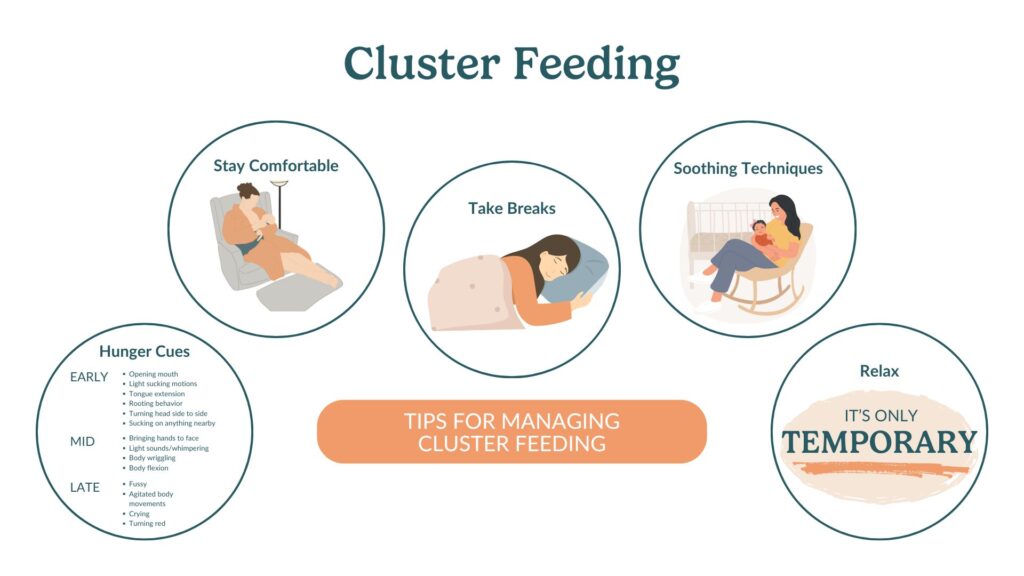cluster feeding

Cluster feeding
Cluster feeding is a pattern where a baby feeds more frequently than usual during certain times of the day, often in the evening. This behavior is normal and can support your baby’s growth and development.
What to watch out for
It’s important to recognize cluster feeding and understand how to manage it. Cluster feeding is a sign that baby’s milk needs are increasing. Allowing baby to cluster feed helps your milk supply keep up with baby’s needs. Here are some considerations and tips:
Benefits
- Supports growth: Frequent feeding during cluster feeding sessions helps meet your baby’s increased nutritional needs during growth spurts.
- Stimulates milk production: Cluster feeding can boost your milk supply by increasing the frequency of feeding.
- Comforts your baby: Frequent breastfeeding can provide comfort and help soothe your baby, especially during times of rapid growth or developmental changes.
Potential Challenges
- Fatigue: Cluster feeding sessions can be tiring and demanding for mamas, especially if they occur during the evening or night.
- Fussiness: Your baby may be fussier during cluster feeding periods, which can be challenging to manage. It can sometimes feel tricky to tell if baby is hungry, tired, or just fussy. Learn more about hunger cues
Tips for Managing Cluster Feeding
- Follow your baby’s lead: Feed your baby whenever they show signs of hunger, even if it seems frequent. This helps ensure they are getting enough milk and supports your milk supply. Learn more about on-demand feeding
- Stay comfortable: Find a comfortable spot for feeding and use pillows for support to reduce fatigue. Have snacks and water nearby to stay nourished and hydrated.
- Take breaks: If you feel overwhelmed, take short breaks when your baby is calm or resting. Ask for help from family or friends to get some rest.
- Soothing techniques: Use soothing techniques such as rocking, swaddling, or a warm bath to help calm your baby during fussy periods.
- Relax: Remember that cluster feeding is temporary and typically occurs during growth spurts. Your baby’s feeding pattern will likely return to normal in a few days.
Physical limitations or health circumstances
Certain conditions can influence cluster feeding and how you manage it:
- Low milk supply: If you’re concerned about your milk supply, cluster feeding can help increase production. Frequent feeding stimulates more milk production. Learn about power pumping
- Premature birth: Preemies may have different feeding patterns, but cluster feeding can still occur as they grow and develop.
- Health conditions: If you or your baby have health conditions that affect feeding, work with a healthcare provider to manage cluster feeding effectively.
Other terms
Understanding related terms can help you better manage cluster feeding and related practices:
- Growth spurts: Times when your baby’s growth accelerates, often leading to increased hunger and more frequent feeding. Learn more about growth spurts
- Hunger cues: Signs that your baby is hungry, such as rooting, sucking on hands, and becoming more alert. Learn about hunger cues
- Let-down reflex: The release of milk from the breast triggered by your baby’s sucking. Learn about let-down
- On-demand feeding: Feeding your baby whenever they show signs of hunger, rather than on a fixed schedule. Learn more about on-demand feeding
- Lactation consultant: A professional who can provide support and guidance on breastfeeding and feeding issues.


